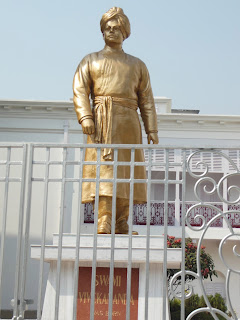A few days ago I was having a discussion with my friend about science and spirituality. The focus was on the verification process in each field. Science demonstrates a principle through an experiment, and those who have sufficient background can accept the principle as a fact without performing the experiment themselves. On the other hand, spiritual principles cannot be demonstrated objectively to someone else and the onus is on the individual to take up that quest to discover their veracity for oneself. Therefore, spirituality-science debates are irresolvable due to their different verification procedures. Unfortunately this self-experimentation, which is the cornerstone of spirituality, is sometimes discarded and a belief system is adopted thereby making oneself susceptible to the manipulations of charlatans commonly seen these days.
Beliefs with no support of reasoning could lead one astray, but they also form the pillar to be held onto by any spiritual aspirant, as they are the markers that need to be realized in one’s journey. Belief in the statements of great sages (of the not so recent past) that have experienced the Truth and the practices they advocate reaching the same is what constitutes an intelligent belief system. Their experiences given in scriptures are sure to be correct, as they have withstood the tests through ages by various sages later on. The very fact that they exist today confirms their veracity, as those that were not true would have lost their relevance over time. For those whose focus is on principles, such a belief system would suffice to get guided well.
However, if one wants to follow the teachings of a living person (or a person in the very recent past) popularly known to be “enlightened,” then a little more caution must be exercised, as their statements have not withstood the rigorous tests over ages. It is not for the ignorant to determine who an “enlightened” person is, and popularity is never a criterion for enlightenment. Also, people tend to make this popular “enlightened” person as a special entity distinct from every one else and begin to worship him/her as a Savior of this world. The idea of prophet, incarnation, messiah etc. is usually attributed to him/her. While some religions claim that there was only one such entity in the past and that was the only one there ever will be, some others have more open minds and accept that these special entities could come anytime anywhere. Now this particular belief leads to personality worship, which by itself is praiseworthy, as it transforms the lives of the followers for the better, but it may sometimes make one overlook the principles that form the basis of spirituality. Regardless of this special entity being actually enlightened or not, which anyway cannot be objectively verified, the same test must be applied to his/her statements and actions too: do they conform to the scriptures that withstood the tests over many ages? Remarkably, through such a test, even if a sincere worship of a charlatan is done, the follower who leads the life following the statements of this charlatan that corroborate with the scriptures will be truly benefited.
So in an experiential subjective field like spirituality, experimentation by every individual is necessary unlike in science where intellectual objectivity is sufficient. Hence in spiritual field this self-experimentation is not only for those with analytical bent of mind, but also for the devotional type. Spirituality demands everyone, be it a devotee or a philosopher, to be an experimental scientist unlike science – it is therefore, more of a science than science itself.
